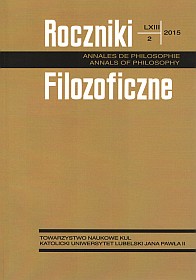The Understanding of Symbols and Their Role in the Ascent of the Soul to God in Pseudo-Dionysius the Areopagite and Nicholas of Cusa
Abstract
This article considers the issue of changes in the understanding of symbols as an integral part of spiritual life in Neoplatonic philosophy. It seems that ancient Neoplatonic philosophers were the first who clearly realized the importance of symbols to spiritual life. However, it happened due to the influence of the mystical Chaldean and Egyptian thought transferred to philosophical investigation by the Chaldean oracles and Corpus hermeticum. The late Neoplatonic thought of Iamblichus and Eastern Neoplatonic schools used symbols and rituals as integral parts of philosophical investigation, understood as having a mystical goal. Especially mathematical symbols played a significant role, because they were used in the most advanced theurgical rituals. This analysis of the pagan Neoplatonic philosophy permits us to show properly the thought of Pseudo-Dionysius the Areopagite, who creatively transformed the teaching of his pagan predecessors, by incorporating ancient Neoplatonic tradition into Christian theology. Pseudo-Dionysius excludes liturgical symbols from the order of the cosmos and transfers them to the plane of Salvation grounded in Biblical Revelation. Only true symbols are used in the liturgy of the Church, and thus mathematical symbols are no longer needed in the ascent of the soul to unity with God. The third part analyzes the meaning of symbolism in the thought of Nicolas of Cusa. Thanks to the rediscovery of ancient pagan Neoplatonism and Pythagorean thought, Cusanus also brings new life to the mystical meaning of mathematics. Mathematical symbols once again become an important part of the mystical ascent of the soul, but this time without their ritual context.
References
Bloom, Paul Richard. Philosophy of Religion in the Renaissance. Farnham: Ashgate, 2010.
Burtt, Edwin A. The Metaphysical Foundations of Modern Science. Mineola: Dover Publications 2003.
Cassirer, Ernst. The individual and the Cosmos in Renaissance Philosophy. Translated by Mario Domandi. Mineola: Dover Publications, 2000.
Dillon, John. “Plotinus and the Chaldean Oracles.” In Platonism in the Late Antiquity, edited by Stephen Gersh and Charles Kannengiesser, 131–140. Notre Dame: University of Notre Dame Press, 1992.
Iamblichus. De mysteriis: translation, introduction and notes by Emma C. Clarke, John M. Dillon, and Jackson P. Hershbell. Atlanta: Society of Biblical Literature, 2003.
Moran, Demot. “Nicholas of Cusa (1401–1464): Platonism at the Dawn of Modernity. In Platonism at the Origins of Modernity. Studies on Platonism and Early Modern Philosophy, edited by Douglas Hedley and Sarah Hutton, 9–29. Dordrecht: Springer, 2008.
Nicholas of Cusa. De docta ignorantia, edited by Ernest Hoffmann and Raymond Klibansky. Leipzig: Meiner, 1932; On Learned Ignorance. Translated by Jasper Hopkins. In Nicholas of Cusa on Learned Ignorance: A Translation and Appraisal of De Docta Ignorantia. Minneapolis: A.J. Benning Press, 1981.
Pseudo-Dionysius. The complete works. Translated by Colm Luibheid, New York: Paulist Press 1987.
Russell, Norman. The Doctrine of Deification in the Greek Patristic Tradition. Oxford: Oxford University Press, 2004.
Shaw, Gregory. Theurgy and the Soul. University Park: Pennsylvania State University Press, 1995.
Wear, Sarah Klitenic, and John M. Dillon. Dionysius the Areopagite and the Neoplatonist Tradition: Despoiling the Hellenes. Aldershot: Ashgate, 2007.
Copyright (c) 2015 Roczniki Filozoficzne

This work is licensed under a Creative Commons Attribution-NonCommercial-NoDerivatives 4.0 International License.





